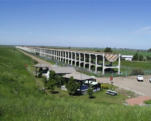Medicine Hat shortlisted for major hemp product processing plant
By COLLIN GALLANT on November 26, 2021.
cgallant@medicinehatnews.com@CollinGallant Medicine Hat is a leading candidate for a new 200,000 square-foot processing plant that would employ 80 workers to turn hemp fibre into base material for car fenders, plywood, consumer plastics and construction material. Inca Renewables describes the product as a bio-composite, a mixture of resin and plant fibre formed into pellets, then heated and formed into high-strength, low-weight construction and manufacturing material. It produces four product lines, and is seeking a Western Canadian base of operations to receive hemp byproduct, process it and then distribute to industrial customers. “We’re looking at a couple locations in the Prairies that are in the zone of optimum hemp growing, and we really like Medicine Hat,” said Camille Saltman, chief marketing officer for the company. “I see an airport and a lot of attributes – lifestyle, workforce – as optimal (as well as transportation network). We’ll be bringing in 40,000 tonnes of hemp fibre and have to ship out.” She expected a decision on location for a newly constructed plant by the end of 2021. The plan for an undisclosed Western Canadian location was outlined in a series of press releases from the company this fall after it secured a supply agreement from major RV manufacturing interests in the United States. Inca already has a location picked out in Indiana to create seamless composite material to be used as an alternative to high-end plywood. That plant would receive premium feedstock processed in Western Canada, where some product lines would also be based, said Saltman. That potentially includes material to be used in construction or creating “more sustainable” items usually made of petroleum-based consumer plastic. The Hat was specifically mentioned as the project site on Wednesday when Drayton Valley-Devon MLA Mark Smith made a general statement in the legislature about support for the Alberta Hemp Industry. “The world needs more Alberta energy, but I truly believe it also needs more Alberta hemp,” said Smith after providing some details about the plan. “This is an opportunity to diversify our agricultural economy and create value-added products right here in the province. Let’s not miss this chance.” Value-added ag processing has been a main leg of regional and provincial economic development plans for several years. It isn’t the first time the hemp or value-added cannabis-related industry has been bandied about in southeast Alberta. Sources tell the News a 2019 proposal by Colorado CBD firm Folium Biosciences to build a major CBD oil extraction facility in the Hat has been shelved indefinitely. The Aurora Cannabis greenhouse, which was partially completed toward growing 250,000 kilograms per year of cannabis flower – not hemp – is currently up for sale. The Inca proposal would be to use leftover stalk after protein or oil extraction to make a composite that would be a highly insulating alternative to plastic, wood, carbon-fibre and even concrete, as well as animal bedding. “It’s a very strong material,” said Saltman. “Medicine Hat is in the middle of about a 300-kilometre radius of some of the biggest and best hemp crops in North America.” She cited support and help from local economic developers in the southeast, as well as provincial ministries as reasons the company is interested in Alberta. The Vancouver-based private company announced initial plans this fall after it secured a supply contract with U.S. recreational vehicle maker Genesis Products, of Indiana. Company officials told the Western Producer the Western Canadian hub would receive deliveries from across the Prairies, then process the bales of stalk into pellets for further processing by industrial customers. It also has an agronomy division to contract with producers for supply arrangements led by Dan Fieldberg, a well-known area hemp producer and ag business developer. Hemp was promoted as a major opportunity for farmers in the Highway 3 corridor as heavy regulations on the marijuana-related crop began to loosen four years ago. The traditionally hardy plant produces marketable quantities of protein (for food additive), CBD oil (for makeup and pharmaceutical use), and fibre, without much of the intoxicating agent found in cannabis. 24-23




